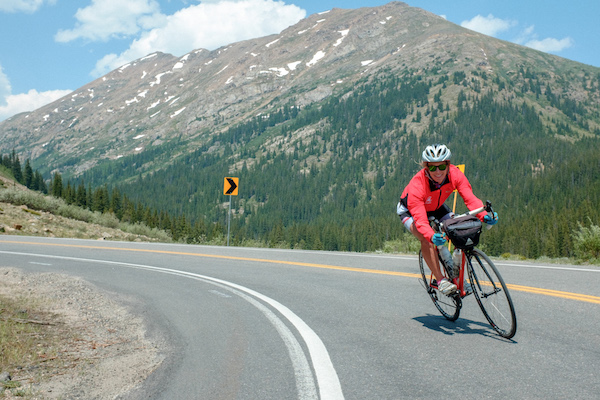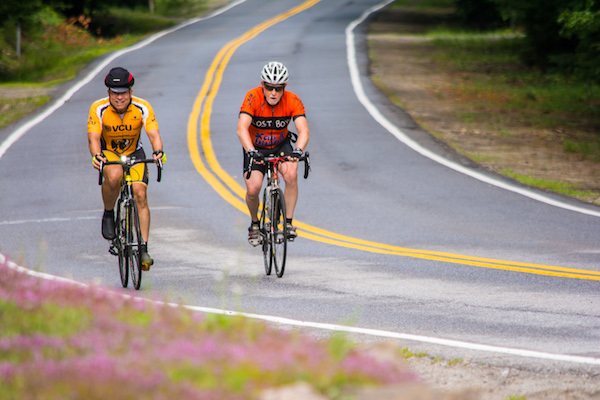
Training for a Hilly Bike Tour
Have a hilly bike tour coming up, but no place to practice your climbing? Here are some key workouts to simulate hill training so you can prepare for the mountains even if you live in the flats!
 Here at our headquarters in Pennsylvania, we love riding hills — and there are plenty of them! We actually have a hard time finding cycling routes that don’t include giant climbs. But some folks aren’t that “lucky.”
Here at our headquarters in Pennsylvania, we love riding hills — and there are plenty of them! We actually have a hard time finding cycling routes that don’t include giant climbs. But some folks aren’t that “lucky.”
Maybe you live in Michigan, but you’re training for the Adirondacks bike tour. Or you might be a rail-trail rider looking to tackle the rolling roads of the Badlands in our Mickelson Trail and the Badlands tour. Don’t worry! There are plenty of ways to get ready for the hills, even for the elevation-deprived!
How to Simulate Hill Training on Your Bike
Strength Training
A strength training routine that includes hip extension exercises (leg press, squats, step-ups) will help you climb hills, even when you don’t have any at home! Use low weights and high repetitions at first to strengthen your tendons and ligaments, then start adding heavier weights and lower repetitions to help improve your strength—and ultimately power—on the bike.
Core Strength
Have you ever had a sore back after a hard ride? That’s because your legs have a lot more stamina than your core. You’ll notice this especially on long climbs, where your body position is different. Combine position with high effort and some people get back spasms. Build your core strength with crunches, back extensions and other various core strength exercises. You can also do pilates or yoga to build core strength—and balance as well.
Flexibility
To compliment your strength routine, include a stretching routine to improve or maintain flexibility. It’s impossible to maintain good riding position if your hamstrings and back are tight and inflexible.
Use a Bigger Gear
On some of your regular routes, use a bigger gear than you normally would, and try to maintain the same speed. This slows your cadence and increases the force you apply to the pedals. Just like riding up a hill!
Ride Into a Headwind
If you live somewhere windy, use that to your advantage! Start riding into the wind. You’ll need to generate more force to ride against the wind, similar to riding uphill. Play with your body position to stay low and aerodynamic, while trying to maintain a reasonable speed.
Lactate Threshold Training
Okay, now we’re getting technical. But lactate threshold (LT) training isn’t as complicated as it sounds. Basically, your LT is the fastest pace you can maintain for a while without keeling over. It’s not an easy effort, and it’s not a sprint. Your LT is somewhere in between.
So how does this help? Well, you can do LT training on flats! You can even do it in a spin class at the gym.
How to do it: start with a 10-minute warmup spin, then ride hard for another 10 minutes. You should be breathing hard, but not so hard that you’re seeing double! Rest, then repeat your effort one or two more times. Congrats! You’ve done a workout!
You’ll have an advantage on the hills, especially if your tour contains mountain climbs (i.e. Colorado Kick Some Pass) that require long and sustained efforts. LT training helps you get into a rhythm and hold a strong, steady pace.
How to set up your bike
Make sure your bike is equipped with appropriate climbing gears. For road riders doing a hilly tour, consider using a triple chainring or a compact crank setup with a large cassette on the rear wheel. Trying to tough it out with gearing designed for flat roads could put you at risk for knee soreness—potentially forcing an early end to your ride. You’ll be happy to know that our rental bikes are fully equipped for climbing!
While you can’t totally replace good hill training when you live somewhere flat, you can do a few things that do help your climbing ability. With all these suggestions, be sure to begin conservatively and increase the training load as you gain more fitness!
Wilderness Voyageurs offers fully supported, inn-to-inn bicycle vacations!
Call us at 800-272-4141

